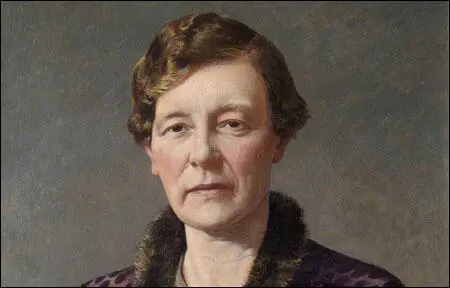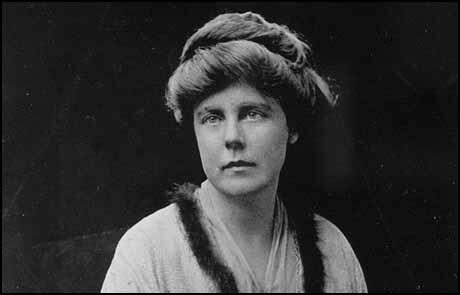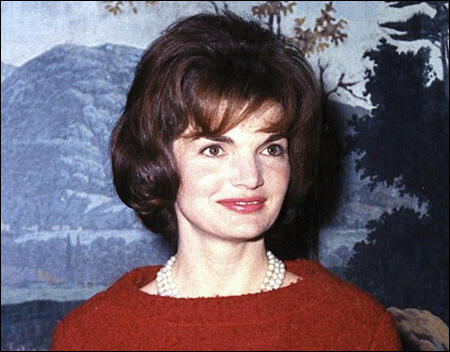On this day on 28th July
On this day in 1873 Louisa Garrett Anderson was born. Her father, James George Skelton Anderson, was a co-owner of the of the Orient Steamship Company. Her mother, Elizabeth Garrett Anderson, had become the first woman to qualify as a doctor. Both her mother and her aunt, Millicent Garrett Fawcett, were leading figures in the National Union of Women's Suffrage Societies.
Louisa was initially educated at home where one of her tutors was the feminist, Hertha Ayrton. Later she attended St Leonards School and Bedford College before entering the London School of Medicine for Women. She qualifying as a surgeon in 1897. Louisa was also active in the struggle for the vote and in 1903 she became chair-person of the Fulham branch of the NUWSS. However, she became very frustrated by the lack of progress in getting the vote and in 1907 she joined the Women Social & Political Union.
Evelyn Sharp spent time with Louisa and Elizabeth Garrett Anderson at their cottage in the Highlands: "Her daughter, who brought the same gifts of courage and perception, so rare in combination, to the service of the same cause, inherited all her mother's brains and culture, and more than her personal charm and gentleness. Her friendship was one of those I gained at that troublous time, and it offered generous compensation for many losses."
In October 1909 the Tax Resistance League was founded at a meeting at her flat in Harley Street. She also led the Medical Women Graduates section of the WSPU procession held on 21st June 1910. Anderson was arrested during a protest at the House of Commons in November but was released without charge.
In March 1912 the WSPU organised a new campaign that involved the large-scale smashing of shop-windows. May Billinghurst agreed to hide some of the stones underneath the rug covering her knees. According to Votes for Women: "From in front, behind, from every side it came - a hammering, crashing, splintering sound unheard in the annals of shopping... At the windows excited crowds collected, shouting, gesticulating. At the centre of each crowd stood a woman, pale, calm and silent." Louisa Garrett Anderson was arrested during this demonstration and was sentenced to six weeks in Holloway Prison.
Millicent Garrett Fawcett was upset when she heard the news and wrote to her sister, Elizabeth Garrett Anderson: "I am in hopes she will take her punishment wisely, that the enforced solitude will help her to see more in focus than she always does." However, the authorities realised the dangers of her going on hunger strike and released her. In a speech she made on 18th April 1912 she announced she had been released because "the Home Office found that I might like to spend Easter with my family." She sent a letter to the British Medical Journal complaining about her preferential treatment.
Louisa Garrett Anderson was involved with Flora Murray and Catherine Pine in running the Notting Hill nursing home that WSPU members went to while recovering from hunger strikes. In 1912 she joined with Murray to establish the Women's Hospital for Children in the Harrow Road.
The summer of 1913 saw a further escalation of WSPU violence. In July attempts were made by suffragettes to burn down the houses of two members of the government who opposed women having the vote. These attempts failed but soon afterwards, a house being built for David Lloyd George, the Chancellor of the Exchequer, was badly damaged by suffragettes. This was followed by cricket pavilions, racecourse stands and golf clubhouses being set on fire.
Some leaders of the WSPU such as Emmeline Pethick-Lawrence, disagreed with this arson campaign. When Pethick-Lawrence objected, she was expelled from the organisation. Others like Louisa Garrett Anderson and Elizabeth Robins showed their disapproval by ceasing to be active in the WSPU. Sylvia Pankhurst also made her final break with the WSPU and concentrated her efforts on helping the Labour Party build up its support in London.
On 4th August, 1914, England declared war on Germany. Two days later the NUWSS announced that it was suspending all political activity until the war was over. The leadership of the WSPU began negotiating with the British government. On the 10th August the government announced it was releasing all suffragettes from prison. In return, the WSPU agreed to end their militant activities and help the war effort.
During the First World War a group of wealthy suffragettes, including Janie Allan, decided to fund the Women's Hospital Corps. Louisa Garrett Anderson joined forces with Flora Murray to run a hospital in Claridge Hotel in Paris. Fellow WSPU member, Evelyn Sharp, who visited them in France, remarked: "It was in a way a triumph for the militant movement that these two doctors, who had been prominent members of the W.S.P.U., were the first to break down the prejudice of the British War Office against accepting the services of women surgeons." In February 1915 Anderson and Murray took charge of the Endell Street Military Hospital in London. Anderson was chief surgeon and the hospital treated 26,000 patients before it closed in 1919.
After the passing of the Qualification of Women Act the NUWSS and WSPU disbanded. A new organisation called the National Union of Societies for Equal Citizenship was established. As well as advocating the same voting rights as men, the organisation also campaigned for equal pay, fairer divorce laws and an end to the discrimination against women in the professions.
Anderson lost her early radicalism and joined the Conservative Party. In 1934 she became a justice of the peace and later became the mayor of Aldeburgh, Suffolk. She never married and was the constant companion of Flora Murray until her death from rectal carcinoma in 1923.
During the Second World War Anderson joined the surgical staff at the Elizabeth Garrett Anderson Hospital. In 1943 she was found to have disseminated malignant disease, and was taken to a nursing home in Brighton, where she died on 15th November 1943. Louisa was cremated and her ashes scattered locally, but her family arranged for an inscription commemorating her friendship and work with Flora Murray to be placed on the latter's tombstone in the churchyard at Holy Trinity Church near to her home in Penn, Buckinghamshire.

On this day in 1879 Lucy Burns was born in Brooklyn, New York City. An Irish Catholic, Burns studied at Vassar and Yale Graduation School before teaching English at Erasmus High School.
In 1906 Burns moved to Germany to study languages. This included spells at the University of Berlin (1906-1908) and the University of Bonn (1908) before continuing her studies at Oxford University.
While in England, Burns joined the Women's Social and Political Union (WSPU) and her activities resulted in her being arrested and imprisoned. She met Alice Paul, another American working with the WSPU and when they returned home the United States they formed the Congressional Union for Women Suffrage (CUWS).
Burns and Paul attempted to introduce the militant methods used by the Women's Social and Political Union in Britain. This included organizing huge demonstrations and the daily picketing of the White House. Over the next couple of years the police arrested nearly 500 women for loitering and 168 were jailed for "obstructing traffic". Paul was sentenced to seven months imprisonment but after going on hunger strike she was released.
After the United States joined the First World War in 1917, Burns was continually assaulted by patriotic male bystanders, while picketing outside the White House. Arrested several times, she spent more time prison than any other American suffragist. Doris Stevens claimed that Lucy Barnes became the most important figure in the militant campaign: "It fell to Lucy Burns, vice-chairman of the organization, to be the leader of the new protest. Miss Burns is in appearance the very symbol of woman in revolt. Her abundant and glorious red hair burns and is not consumed - a flaming torch.... Musical, appealing, persuading - she could move the most resistant person. Her talent as an orator is of the kind that makes for instant intimacy with her audience. Her emotional quality is so powerful that her intellectual capacity, which is quite as great, is not always at once perceived."
Burns retired from political life after women in the United States got the vote. She was reported as saying: “I don’t want to do anything more. I think we have done all this for women, and we have sacrificed everything we possessed for them, and now let them fight for it now. I am not going to fight anymore.”
Lucy Burns died Brooklyn, New York City, on 22nd December, 1966.

On this day in 1923 Flora Murray from rectal carcinoma. She was buried in the churchyard at Holy Trinity Church near to her home in Penn, Buckinghamshire.
Flora Murray was born on 8th May, 1869. She trained at the London School of Medicine for Women and finished her course at Durham. She then worked in Scotland before returning to London in 1905. She was a medical officer at the Belgrave Hospital for Children and then anaesthetist at the Chelsea Hospital for Women.
In November 1908 she signed a petition sponsored by the National Union of Women's Suffrage Societies. Soon afterwards she joined the Women Social & Political Union. It has been argued by Rebecca Jennings, the author of A Lesbian History of Britain (2007), that Murray was a lesbian and lived for many years with Elsie Inglis.
In 1909 she stood surety for Marion Wallace-Dunlop. She attended several demonstrations where along with her great friend, Louisa Garrett Anderson, she helped treat those members of WSPU who were injured. She was also involved with Anderson and Catherine Pine in running the Notting Hill nursing home that WSPU members went to while recovering from hunger strikes. In 1912 the two women established the Women's Hospital for Children in the Harrow Road.
On 4th August, 1914, England declared war on Germany. Two days later the NUWSS announced that it was suspending all political activity until the war was over. The leadership of the WSPU began negotiating with the British government. On the 10th August the government announced it was releasing all suffragettes from prison. In return, the WSPU agreed to end their militant activities and help the war effort.
During the First World War a group of wealthy suffragettes, including Janie Allan, decided to fund the Women's Hospital Corps. Murray joined forces with Louisa Garrett Anderson to run a hospital in Claridge Hotel in Paris. Fellow WSPU member, Evelyn Sharp, who visited them in France, remarked: "It was in a way a triumph for the militant movement that these two doctors, who had been prominent members of the W.S.P.U., were the first to break down the prejudice of the British War Office against accepting the services of women surgeons." In February 1915 Anderson and Murray took charge of the Endell Street Military Hospital in London. Anderson was chief surgeon and the hospital treated 26,000 patients before it closed in 1919.

On this day in 1929 Jacqueline Bouvier, the daughter of a New York City financier, was born in Southampton, New York, was born. She worked as a photographer with the Washington Times before marrying John F. Kennedy in 1953. Over the next few years four children were born but only two, Caroline and John, survived infancy.
In 1960 Kennedy, the Democratic Party candidate, was elected president when he defeated Richard Nixon, the Republican Party candidate, by 34,226,925 votes to 34,108,662.
On 22nd November, 1963, Kennedy was assassinated in Dallas, Texas. Within two hours of the killing, a suspect, Lee Harvey Oswald, was arrested. Throughout the the time Oswald was in custody, he stuck to his story that he had not been involved in the assassination. On 24th November, while being transported by the Dallas police from the city to the county jail, Oswald was shot dead by Jack Ruby.
In 1968 Jackie Kennedy married the Greek shipping magnate, Aristotle Onassis. Later she worked as an editor for the publishers, Viking (1975-1977) and Doubleday (1978-82).
Jacqueline Kennedy Onassis died on 19th May 1994.


